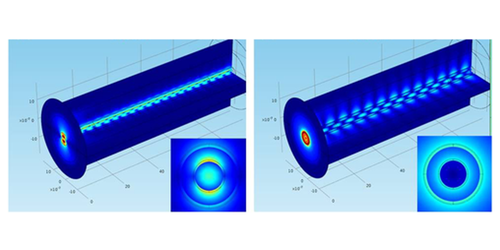Nanoscale Device Amplifies Fiber-Optic Signals
As information technology evolves toward the use of optical rather than electrical signals, it requires ever more precise and powerful means for guiding and amplifying light. Researchers now report the creation of an optical amplifier—suitable for light of standard communication frequencies—that is times more powerful than previous devices. Better yet, it’s small enough to fit within an integrated circuit and so could help spur the miniaturization of nanophotonics circuitry.
Optical telecommunications technology often uses a standard wavelength of about micrometers, which is near infrared light. Until now, effective amplifiers for such light have been larger than a micrometer in size, making them unsuitable for integrated circuits. Smaller devices have either leaked too much light or have been unable to achieve strong amplification.
To address these problems, a team led by Anlian Pan of Hunan University in China and Xiangfeng Duan of the University of California at Los Angeles designed an amplifier based on an optical nanowire with a core-shell structure—a central core of silicon, surrounded by a thick shell of erbium/ytterbium silicate material. The team’s idea was that as light propagated through the nanowire, the core-shell boundary would corral much of the light, but a large fraction would also leak outward into the shell, where it would be amplified. The amplification would come from erbium atoms emitting infrared photons in response to “pumping” from shorter-wavelength laser light. The amplifier would consist of a short section of such a nanowire less than a micrometer in diameter.
But Duan points out that making it work requires a delicate balance. The dimensions of the core and shell have to be chosen precisely to confine the light within the nanowire and also to let enough light into the shell, where amplification occurs. The researchers calculated that an inner core diameter of a few hundred nanometers, surrounded by a shell of comparable thickness, might work.
The team then tested this prediction in real nanowires fabricated with different dimensions for the core and shell. Measurements of their optical properties showed that with proper tuning of the core diameter and shell thickness, at least of the optical energy can be kept within the erbium/ytterbium silicate shell and thereby exposed to amplification. The optimal design—with a -nanometer-diameter core and a -nanometer-thick shell—offered a light intensity amplification of roughly times per millimeter of fiber. This gain is more than times larger than anything reported previously for optical amplifiers on the micrometer scale. At the same time, the device is ten times smaller than any previous device.
The key conceptual advance, says Duan, comes from the flexibility of the design. “It allows us to tune the size of the core and shell independently,” he says, “so we can simultaneously minimize the loss of light power and maximize the gain.”
Such an amplifier could be instrumental, he suggests, for a next generation of on-chip optical communications components. The next step will be to explore techniques for manufacturing amplifiers of this kind using the standard lithographic methods of integrated circuit fabrication. If successful, “these amplifiers could be integrated into practical devices quite soon,” says Duan.
Making the new amplifier practical would be a welcome development, according to Stéphane Kéna-Cohen of the École Polytechnique de Montréal in Canada. “This advance could avoid the need for bulky semiconductor amplifiers, which are now commonly used,” he says. An important challenge, he notes, will be developing ways to integrate such nanowires within the complicated geometries of integrated circuits.
This research is published in Physical Review Letters.
–Mark Buchanan
Mark Buchanan is a freelance science writer who splits his time between Abergavenny, UK, and Notre Dame de Courson, France.





